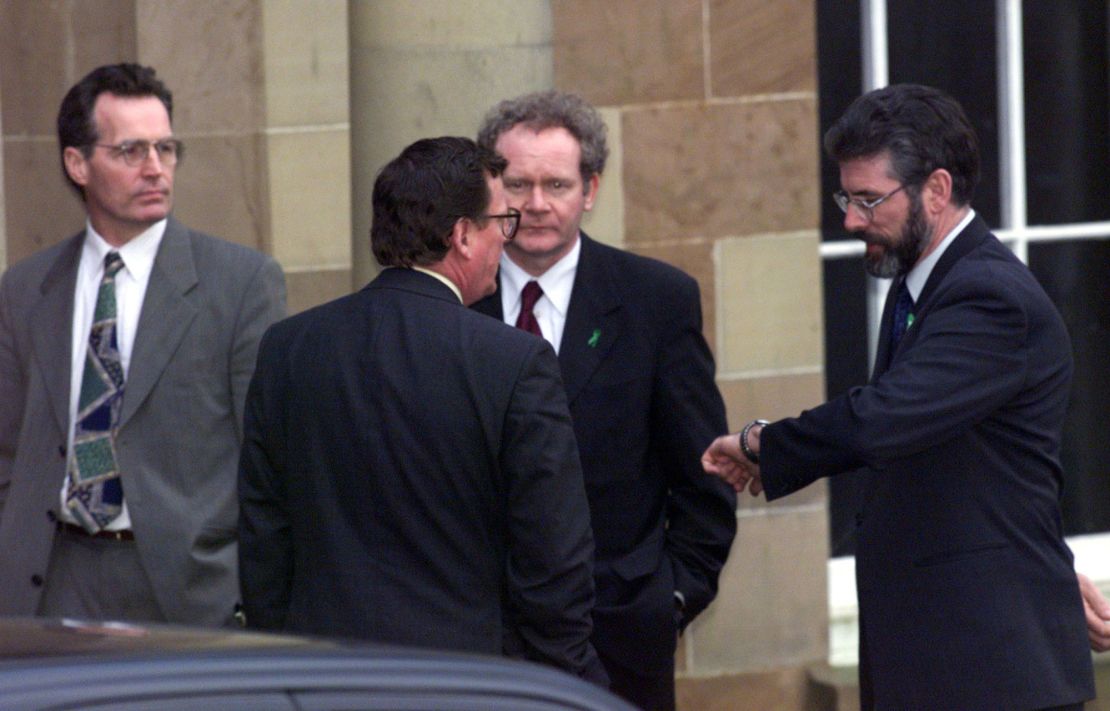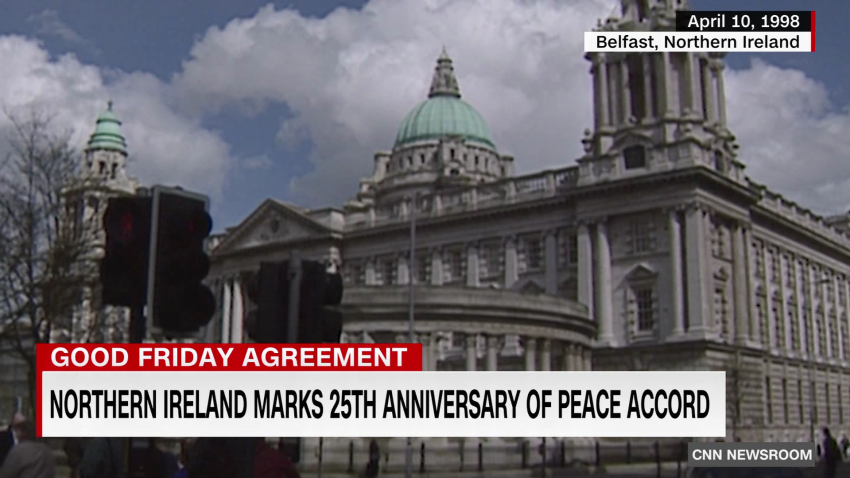There is a forensic cleanliness about the warren of corridors at Castle Buildings on the Stormont estate – now the department of justice building in Belfast, outside “the room where it happened.”
It’s my first time inside the nondescript room where, 25 years ago, the Good Friday Agreement came in to existence as tensions gave way to applause, signaling an end to years of tortuous negotiations and the beginning of Northern Ireland’s peace.
I was outside the building that night of April 9/10, 1998. At around midnight, the tentative deadline set by talks middleman US Senator George Mitchell, President Bill Clinton’s envoy, the ground began to freeze. The spongy grass underfoot became brittle.
Hope’s warmth ebbed, chill settling inside bone. Newspapers still in hand declared it “Destiny Day.” The red banner headline of that April 9 edition of the Belfast Telegraph read “Historic Time for Northern Ireland.”
It was, and had been a long and horrible ride to that moment.
What began in the late 1960s as a campaign for equality and justice by the Catholic community, and was met forcefully by a mostly Protestant police force, morphed into Europe’s ugliest sectarian conflict in a generation.
Catholic killed Protestant, Protestant killed Catholic. British troops flooded in from the mainland and were soon locked in deadly confrontation. Three decades of brutal and utterly ruthless bombings and shootings followed, with more than 3,500 people killed.
Witnesses to the savagery of the early years described Northern Ireland’s second city as akin to London during the Blitz of World War II.

Compromise required
Londonderry/Derry – these days sometimes called “Stroke City” in a humorous reference to its split identity, pro-Irish nationalists calling it Derry, pro-British Unionists calling it Londonderry – epitomized the depth of suffering and anger.
On “Bloody Sunday” on January 30, 1972, British paratroopers shot dead 13 unarmed people and one more died four months later. More than 26 years on at the peace talks, that harrowing event and so many other atrocities remained open wounds.
At the talks in Stormont, gunmen-turned-politicians on all sides had the clout needed to silence the weapons in their communities, but they also had blood on their hands.
Compromise, not forgiveness was needed: In the eyes of some, the British and Irish leaders, Tony Blair and Bertie Ahern were also indirectly culpable – the British government for its responsibility for among others Bloody Sunday, while Loyalists believed the Irish government was secretly supportive of the IRA.
“Parties poised to endorse blueprint for way forward” was another eve of agreement newspaper headline, but behind the closed doors of the 2nd floor meeting room there was little poise, Mitchell feared the talks could collapse.
A few days later in an interview he told me his trick to successful negotiations. “Get both sides to believe a solution can be had,” he said, then, “set them a deadline” and hope they’ll make the concessions needed to get the deal done.
But at midnight on April 9, that had yet to happen.
Outside we reporters had no idea what was going on in the talks room; indeed it wasn’t just one room but a warren of corridors burrowing off in several directions, doors to small offices peppering the walls. Inside many of those tiny spaces opposing factions were separately receiving multiple drafts of the ever-evolving agreement.
Five years earlier I had been standing outside 10 Downing Street in London when the-then British Prime Minister John Major and his Irish counterpart Taoiseach Albert Reynolds had emerged late afternoon to announce the “Downing Street Declaration.”
Neither would be in high office when the Good Friday Agreement was signed, but their historic compromise set the process to peace in motion, and sent me the very next day to Northern Ireland.
At its heart was the concept the DSD, as it was known, was the right of the Irish to solve their problems by “mutual consent,” North and South. Major stated that the British government had “no selfish strategic or economic interest in Northern Ireland.” This was the watershed moment.
But on landing in Belfast’s heavily fortified international Aldergrove airport the next day, confronted in the coming days by roving British Army security patrols and mobile road side checkpoints, it was clear that the words so eloquently uttered in Westminster might waft away on the wild Irish wind and never take root.
A CNN team drove in to so-called “Bandit Country” along the border with the Republic of Ireland, where the Irish Republican Army (IRA) had big warning signs on telegraph poles, like “men at work” road signs – but rather than a figure shoveling a pile of dirt, inside the red triangle was a silhouette of a gunman and the words “sniper at work” painted menacingly underneath.
We visited border towns like Newton Hamilton that were still heavily defended by “rings of steel” – hard barriers and high fences protecting police bases from rocket and gunfire attack.
After the Downing Street Declaration, Northern Ireland still felt at war, but slowly I would see that change, and meet the politicians effecting it.

The Social Democrat and Liberal Party (SDLP), regarded by many as the softer proponents of Irish nationalism, was led by MP John Hume. A warm, friendly man who, no matter how uninformed a journalist may appear, always took the time to explain. His patience was saintly.
In the opposite corner so to speak was Ulster Unionist Party (UUP) MP and lawyer David Trimble: Confident, smart, a little brusque at times, and with good reason – a little nervous about the reconciliation he was undertaking.
Both men played an outsized role birthing the peace, both would win the Nobel Peace Prize for their Good Friday achievement, and both would ultimately be punished at the polls by their voters, who having got peace, flocked to hardline parties on each side of the divide.
That most people wanted peace was rampantly shown by the support for ceasefires called by both Loyalist and Republican paramilitaries.

The IRA was first to call a ceasefire in August 1994, the Loyalist Joint Command two months later. They didn’t hold, with the IRA launching a series of “spectaculars” on mainland UK to get the government’s attention. A truck bomb amid the glassy towers of London’s gleaming Canary Wharf development in 1996 blew out windows in a half-mile radius, killing two people and injuring more than 100 others.
In February 1996 I would witness the aftermath of the last IRA bomb to go off in London. The IRA volunteer carrying it died and eight people were injured when the bomb detonated prematurely on a bus in central London.
The reality was by this stage of the conflict the IRA and Loyalist paramilitaries had become so penetrated by the British intelligence services they were finding it near-impossible to sustain attacks at a tempo to get their demands met.
When the IRA called their next ceasefire the following year, I was outside the Sinn Fein office on the predominantly Catholic Falls Road in Belfast, cheers erupted as the newsreader’s words sunk in. Another chance to end the violence.
Without the gunmen the talks were nothing.
Sinn Fein’s leader Gerry Adams and his close friend Martin McGuinness, by then well-established (in absentia) Westminster lawmakers, still dogged by claims they denied of leadership positions inside the IRA were finally allowed in to the talks.
They would often be seen leaving the talks at Stormont for a conflab outside, knowing the only way to escape eavesdropping bugs was to stroll around the small gardens and whisper their next moves to each other.
Tortuous history
So it was that freezing night April 9. Adams and McGuinness stepping out of the talks building again, perhaps for theater, perhaps for fresh air, perhaps to steady their nerves, or rattle those of the other negotiators.
For sure we couldn’t read the meaning, and so minutes past midnight became hours. Toes froze, fingers numbed. And then came Blair and Ahern, statements were issued, TV interviews done. A deal done, the peace was real, it was all over.
The next episode in Northern Ireland’s tortuous history had begun; that afternoon I would watch one of Belfast’s peace walls getting extended.
Back in Belfast now, the peace walls are still there, dividing the communities, even longer and higher than they were 25 years ago.
The big difference today is that double decker tour buses stop, disgorge dozens of happy holidaymakers who scrawl their names and messages on the concrete, before boarding again, their Belfast experience a little more complete.
With the power-sharing Northern Ireland Assembly currently suspended amid post-Brexit tensions, and a recent uptick in violence in the province, the peace deal is under renewed pressure. Notwithstanding these challenges, the agreement struck on that famous night in 1998 continues to make a real difference: In another 25 years, when today’s tourists are bringing their children back, they might be able to say, “look, that’s where the wall used to be.”

